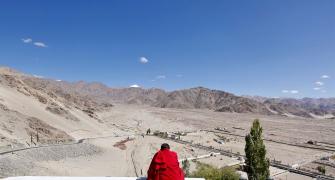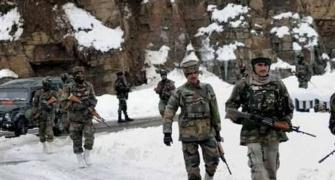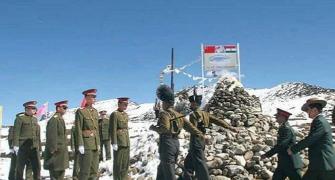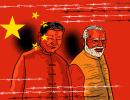'Modi has not taken India into confidence over what is happening and what has happened.'
'We have not even officially been told what the position is with respect to the land lost between Fingers 4 to 8,' observes Aakar Patel.
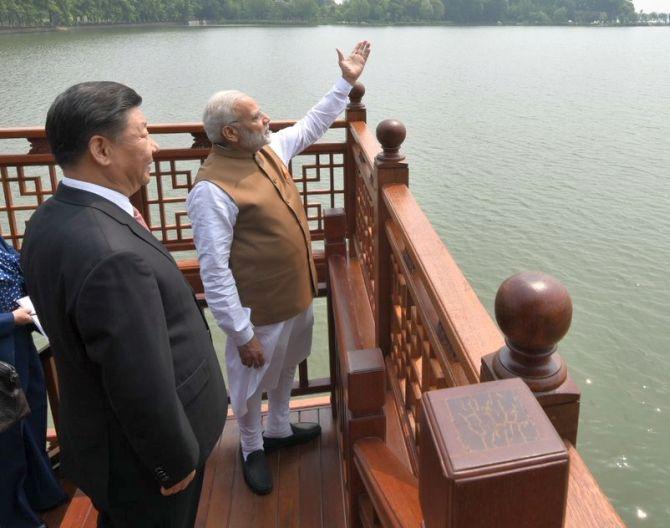
A meeting between India and China took place on Saturday, June 6, about the problem on the Ladakh border.
What does India want? There was a zone in Ladakh which both sides were patrolling till May.
They would send groups of soldiers from one area, called Finger 4, which was near the Indian base, to another area called Finger 8, near the Chinese base.
The patrols would be unarmed and in 90% of the cases there would be no confrontation or a minor one.
In 10% of them there would be some pushing or shoving, but rarely anything serious.
The road from the Indian side to Finger 4 is difficult and can only be travelled on foot and in single file up a mountainside.
The Chinese access is much easier and they have built roads for their vehicles.
Despite the difficulty, India has been regularly reaching Finger 8 and patrolling up to Finger 8 because it is our land and many thousands of Indians died in the 1962 War defending this land.
From May, China has physically stopped Indian patrols from proceeding beyond Finger 4, effectively giving China full control over the entire area.
Reports say the Chinese have moved between 5,000 to 10,000 troops to three places, which are no longer accessible to India.
This is the problem and this is why we are talking today.
What India wants and has failed to get at the previous talks is for the Chinese to go away from our land.
The day before the June 6 talks, India's foreign ministry met with China's and put out a statement saying that the issue would be resolved through 'peaceful discussion'.
Meaning that Narendra Damodardas Modi has ruled out fighting to take back our land and believes that we can get it back through talks.
Armies exist because the capacity for violence is required for a State to compel another State to stop doing what it is doing.
India appears to have surrender that option go when it comes to the Ladakh intrusion and capture.
Is that a wise decision before a negotiation? That depends. What does the opponent want?
Here is the problem.
We know what India wants, but there seems to be no agreement on what China wants and why it is doing this mischief in Ladakh.
The experts of this, who are former soldiers who are now analysts for the media have a few theories.
One is that the scrapping of Article 370 was accompanied by the formation of the Union territory of Ladakh, the issuance of new maps and the claim made in Parliament by the home minister that Pakistan occupied Kashmir and Aksai Chin (which is with China) will be taken back, even at the cost of lives.
This had upset China.
The second theory is that Xi Jinping believes Modi is violating the Wuhan Agreement which the two had signed a couple of years ago.
India and China had agreed to be friends and partners and not rivals.
But recent actions of India such as specifically curbing Chinese investment in Indian companies did not reflect that spirit.
India had also formed an alliance with the United States, Japan and Australia to conduct naval exercises regularly.
China had been threatened by that.
The third is that China wants to ensure that it has more control over its Belt and Road Initiative, by blocking Indian access to the north.
The parts in Ladakh that China has captured lead up to that zone.
This is what China wants.
The fourth theory is that it is a nationalist distraction being spread by Xi because his authoritarian rule has weakened under Covid.
Therefore he is being adventurous in Hong Kong and against India.
These are some of the theories that have been put forward by the experts.
There is no consensus among them about why exactly China is doing what it is.
I should stress here that these are the theories put forward by soldier scholars who admit that they are speculating based on the input they have.
Some of the people who usually write in favour of the government have said there is no intrusion at all and no problem in Ladakh.
In short, China knows what we want, but we do not know what they want.
This is not a good starting point for a negotiation.
India is a democracy and therefore in some ways it has fewer options.
The government is under more pressure from media and the Opposition to provide an immediate solution (meaning the withdrawal of Chinese troops) and if such a thing happens then victory can be declared.
Modi himself has not taken either India or the Opposition parties into confidence over what is happening and what has happened.
We have not even officially been told what the position is with respect to the land lost between Fingers 4 to 8.
The media which puts other parties under pressure at such times is giving Modi a lot of rope.
China can play a longer and bigger game strategically.
Its leadership has no media pressure and so it can pursue its long term objectives by keeping its rivals unstable through such things as this current Ladakh occupation.
What are its long term strategic objectives and how are they aligned to the current crisis? What does it ultimately want? The experts do not know for sure.
One hopes Modi and this government does, as they give up the military option.
Aakar Patel is a columnist and writer.
You can read Aakar's columns here.
Production: Aslam Hunani/Rediff.com

